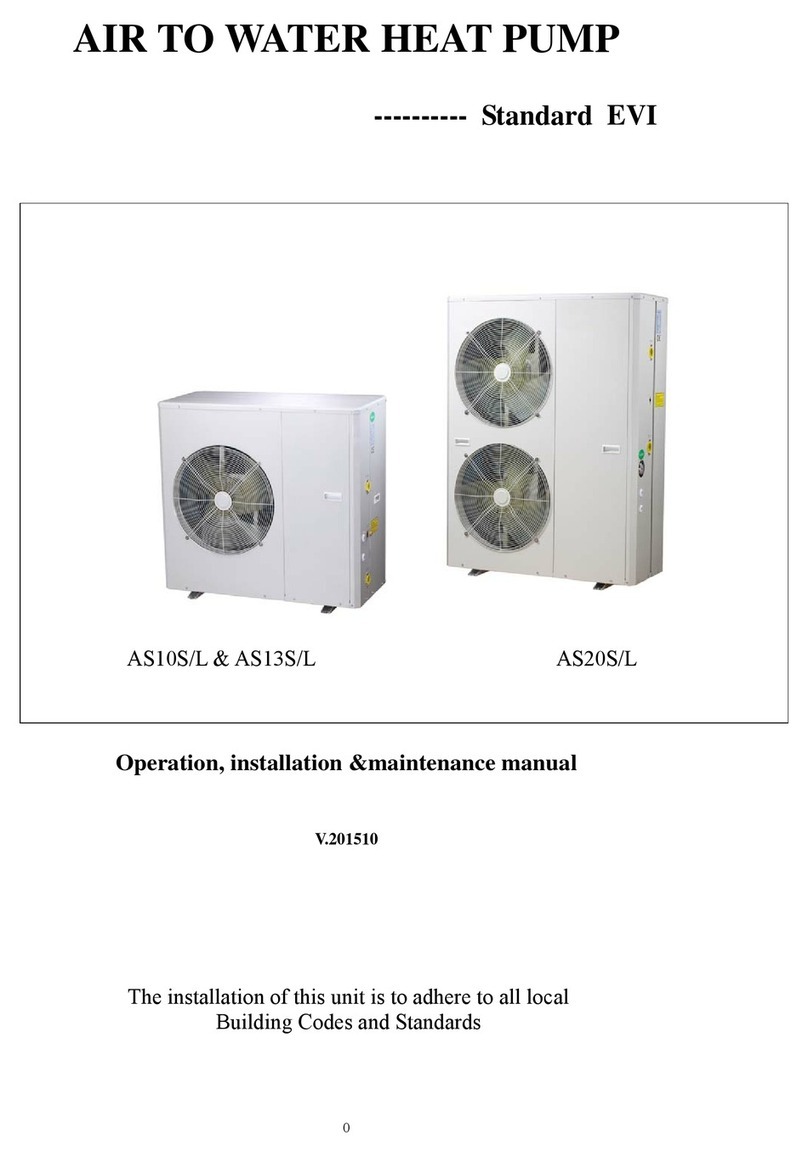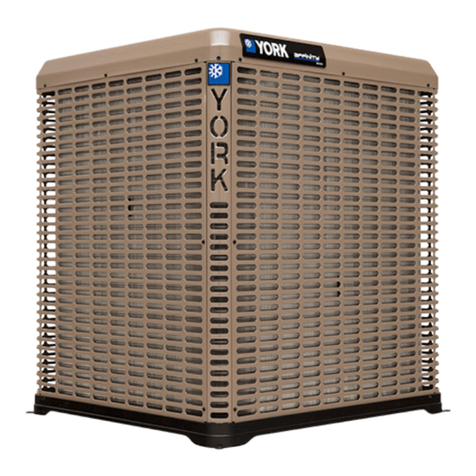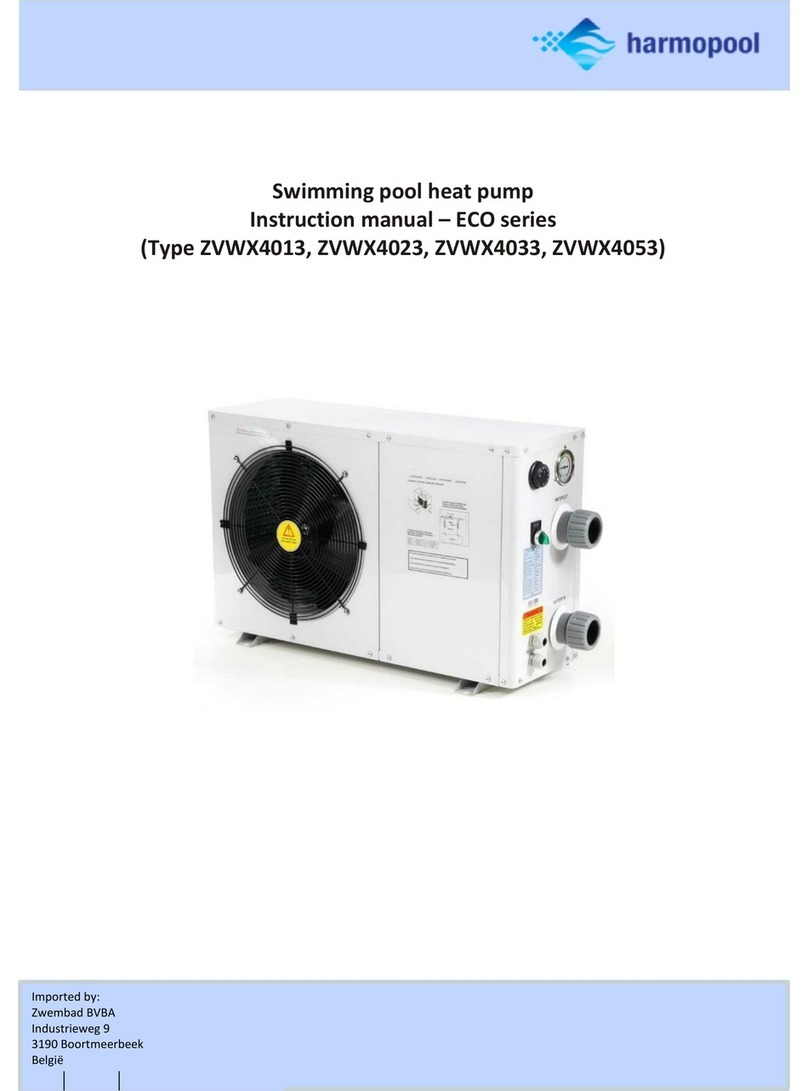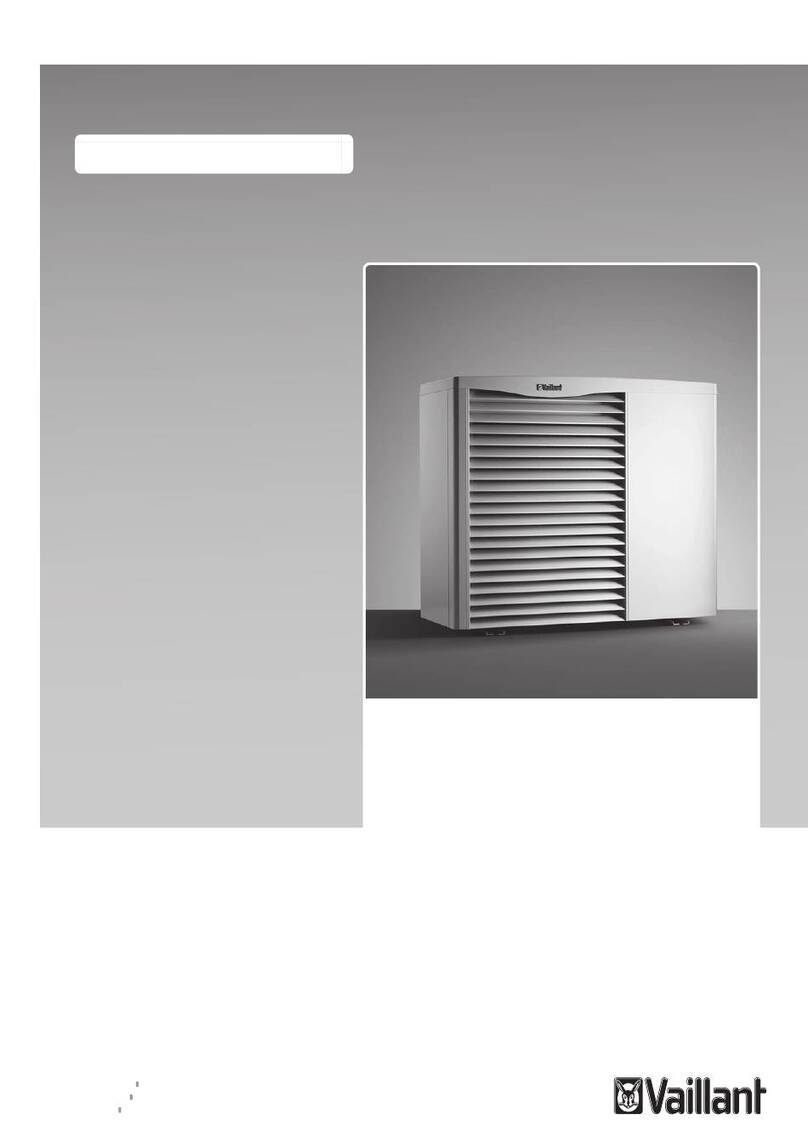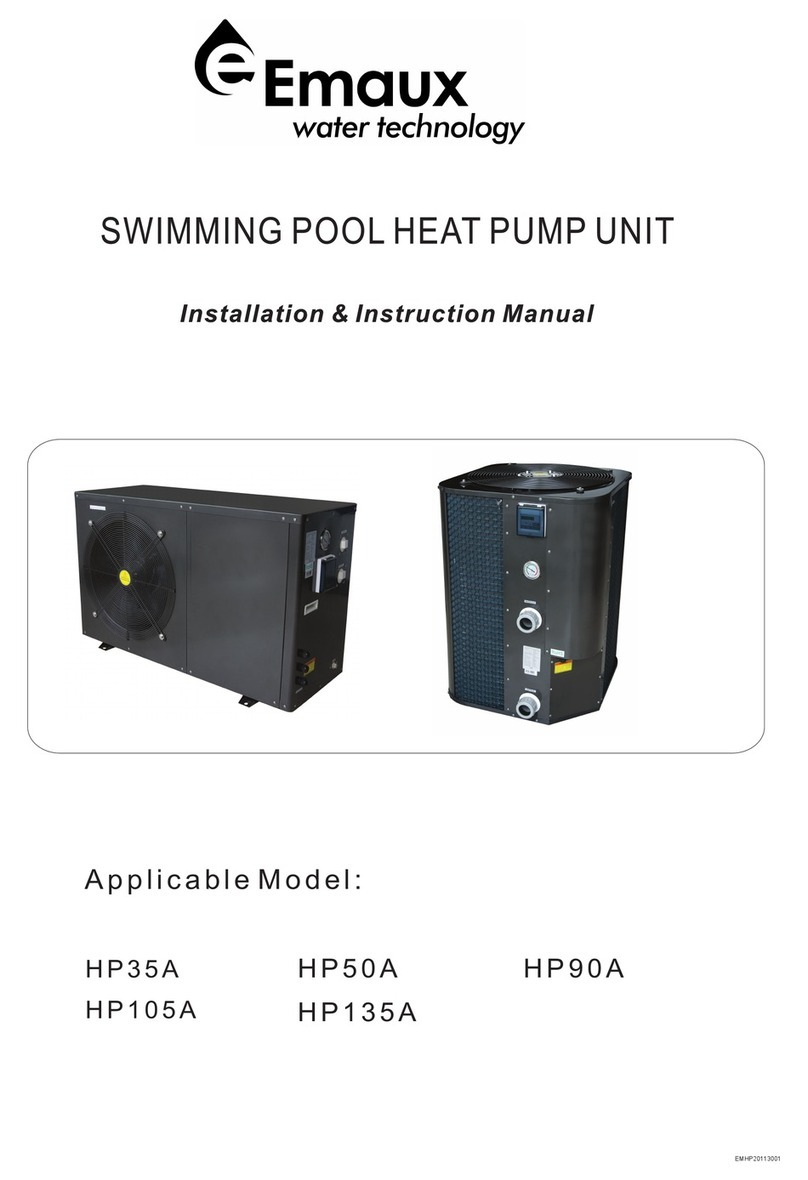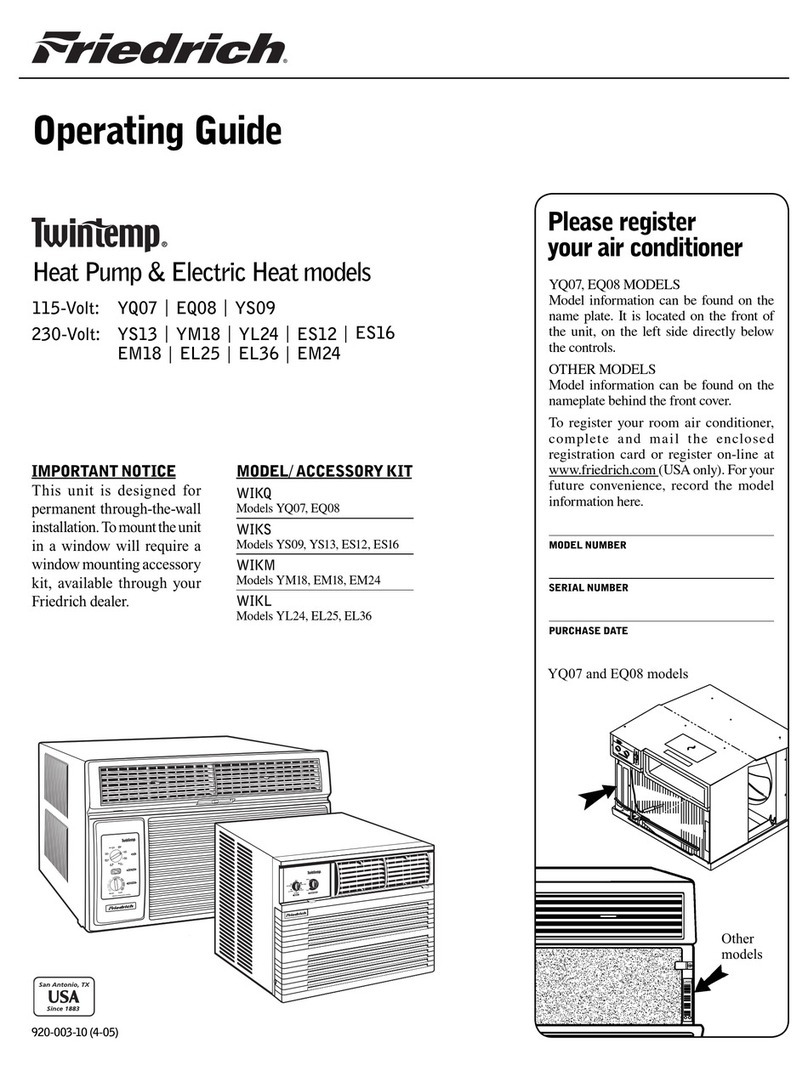HISEER GSWW60 Instruction manual

GEOTHERMAL HEAT PUMP
Installation ,Operation &Maintenance Manual
The Installation of this unit is to adhere to all Local
Building Codes and Standards

1
Pre-Installation
Important Site Instructions
The installation, commissioning, inspection, maintenance and repairs must only be carried out by
a ualified person.
All electrical wiring must be completed by a licensed electrical contractor in accordance with the
appropriate standards.
The drilling work re uires a permit from your local council.
The heating system and heat source must be properly designed and dimensioned to ensure an
efficient operation. It is particularly important to keep water flow temperatures as low as possible.
The minimum heating water flow rate through the heat pump must be assured in all operating
states of the heating system.
Movement and storage
The unit must not be transported, moved or stored at greater than a 30° angle from the upright
position. Install and store the unit in a dry area. They are not rated for outdoor use.
Safety
If a refrigerant leak occurs, remove the complete charge using a recovery unit and store the
refrigerant in mobile container.
Note: care is to be taken as the refrigerant can breakdown due to high temperature, these
refrigerants by-products are dangerous.
Once the leak has been repaired recharge the unit with the correct filling weight and the type
found on the unit’s nameplate.
Note: ensure the correct refrigerant gas is used to recharge the unit as an incorrect gas can cause
damage beyond repair to the compressor.
Do not use oxygen to purge lines or to pressurize a unit for any purpose.
Oxygen gas reacts violently with oil, grease and other common substances.
Use only refrigerant or dry nitrogen for testing.
Never exceed the specified maximum operating pressures.
Do not un-weld or flame cut the refrigerant lines including any refrigerant circuit components
until the entire refrigerant (li uid and vapour) has been removed from unit. Traces of vapour
should be displaced with dry nitrogen.
Refrigerant in contact with an open flame will produces toxic gases.
Ensure that the necessary safety protection e uipment is available when servicing. Have the
appropriate fire extinguishers for that system.
Do not siphon refrigerant.
Avoid spilling li uid refrigerant onto the skin or splashing it into the eyes. Use safety goggles.
Wash any spills from the skin with soap and water. If li uid refrigerant enters the eyes,
immediately and abundantly flush the eyes with water and consult medical advice.
Note: Never apply an open flame or live stream to a refrigerant container. This can dangerously
overpressure and cause an explosion.
Pre-Installation

2
Installation Location and Positioning
The unit must be installed in a protected area that is free from rain and water penetration.
The unit must be installed on a solid level surface, preferably on a concrete pad not connected to
the main house slab foundation.
Allowances for good ventilation around the installation must be provided.
In normal operations to prevent condensation collecting on cold pipes the thermal insulation of
any cold components should be to a high level.
The unit will produce noise that is above the minimum 45 decibel rating. Therefore the unit should
be located so that it is well away from bedrooms, offices, living areas or noise sensitive areas
including neighbour’s bedrooms.
There must be suitable distances between the unit and the building to ensure normal operation and
enough room for maintenance re uirements.
Installation Location and Positioning

3
Buffer Tank
A buffer tank is recommended to ensure a trouble free heat pump operation. A suitable buffer tank
can avoid excessive heat pump cycling (switching on and off).
The buffer tank provides a hydraulic separation from the volume flow in the heat pump and
heating circuits. The volume flow in the heat pump circuit remains constant, even if the heating
circuit volume flow is reduced by thermostatic valves.
If the total of the systems water volume is less than 12L/KW then a buffer tank should be added to
reduce the compressor from ON/OFF cycling. This will prolong the compressor life span.
When a buffer tank is installed, the heating system will absorb energy from the buffer tank first.
To save energy consumption ,install the indoor pump P1 that is switched on only when compressor
is on. This is by changing EV01 to “1”.
RT sensor should be taken out of the unit and put into buffer tank’s sensor pocket. The RT sensor
is located at lower submerged sensor pocket of the plate heat exchanger. The RT sensor in the
buffer tank will control the tank temperature by starting and stopping the compressor and pump
together as re uired.
If RT sensor has not been changed to buffer tank’s sensor pocket when EV01 has been change to
“1”, when the unit reaches its set temperature ,the compressor will stop, pump P1 will also stop
accordingly due to EV01 being set to “1”. When this occurs ,there is no water circulation between
the heat pump and buffer tank. RT will keep its stopped temperature ,not the buffer tank water
temperature. RT then can not switch on compressor and pump P1 even when buffer tank water is
getting cold. Changing the RT sensor into the buffer tank will avoid this problem.
Buffer Tank

4
System Overview Vertical Ground Loop System
Name
Description Location
Name Description
Location
P2 Outdoor side water
pump External OT Outdoor temperature
sensor Internal
SAK
Safety valve External FL Particle filter External
BK Brine tank/expansion
tank External
Systems Overview Outdoor side)

5
System Overview Horizontal Ground Loop System
Name
Description Location
Name Description
Location
P2 Outdoor side water
pump External OT Outdoor temperature
sensor Internal
SAK
Safety valve External FL Particle filter External
BK Brine tank/expansion
tank External
Systems Overview Outdoor side)

6
System Overview Ground Water with Intermediate Heat Exchanger
System
Name
Description Location
Name Description Location
P2 Outdoor side water pump
External OT Outdoor temperature
sensor Internal
P3 Ground water pump External FL Particle filter External
BK Brine tank/expansion
tank External SAK Safety valve External
FW Water flow switch External FI filter External
DP Intermediate heat
exchanger External
Principle of Operation:
An intermediate heat exchanger (DP) should be installed to prevent ground water damaging or
contaminating the unit’s internal heat exchanger. A plate heat exchanger that is able to be cleaned
is recommended for this situation that can be disassembled for cleaning and repair or any damage
plates can be replaced. Anti-freezing measurement must be adopted to protect the ground water
circuit.
Systems Overview Outdoor side)

7
Several units could be connected together to build a large system.
Each controller is set to different cooling, heating set point (2-3 degree difference)so they will not
start at the same time to reduce start current.
All units water pump control signal connected together to A/C contactor which supply power for
water pump so the water pump can run as long as any unit is running.
GSWW60 GSWW60
Connect outdoor
system
Connect
indoor system
soft-joint for reducing vibration
between machine and system
by-pass valve
water pressure gauge
filter
automatic air vent valve
temp gauge
electronic heater
shut off valve
non-returning valve
expansion tank
water pump
water flow switch ( If it is assembled
inside the factory, no need to install)
Systems Overview Indoor side)

8
Heating working principle:
To set two units in parallel operation, set the primary unit to the re uired parameters, unit two is to
have 3~5°C difference of ST01,ST02 and ST05 to allow for energy stage control.
Switch on both units’ A/C switches one by one, if the RT parameter is lower than the set values of
both units, then the units will start to heat together. The unit with the lower ST02+ST04 value will
stop first, the other will stop as well when the RT rises above its set value. Then both units will
stop.
The unit with the higher ST02-ST04 value will start first again to heat when the buffer tank’s RT
drops. If this unit can meet the heating capacity then the RT will not drop any further, only this
unit will run as re uired. If the heating load is bigger than the capacity of one unit then the RT will
continue to drop to below the second unit ST02-ST04 value, the second unit will start increasing
the heating capacity.
Systems Overview Indoor side)

9
Installation
Installation must be carried out in accordance with current Standards and Building Codes
.
The
heat pump does not come fitted with shutoff valves and these must be fitted outside of the heat
pump to facilitate future service
.
Important
The pipe work must be flushed before the heat pump is connected so that any contaminant does
not damage the unit’s internal component parts
.
Gro nd Loops:
When dimensioning the ground collectors, consideration must be given to the geothermal location,
type of rock, soil structure and the size of the heat pump
.
When installing the collector pipe ensure it rises constantly towards the heat pump to avoid air
pockets. If this is not possible install high points to vent the air. The ground collectors must be free
of all air.
All brine pipes that enter any rooms must be insulated against condensation. The expansion tank
(BK) must be installed as the highest point in the collector system and on the incoming pipe before
the brine pump.
Note: Condensation may drip from the expansion tank. Position the expansion tank so that it isn’t
in the way of other e uipment
.
When installing the circulation pump for the brine circuit, position the electric connection at the
12 o’clock position to prevent ingress of condensate.
Ensure ade uate thermal and sound insulation of all pipes routed through wall apertures.
Thermally insulate pipes on the inside buildings and installed with a vapour seal. As the
temperature of the ground collector system can fall below 0°C, the fluid must be protected against
freezing down to –15°C. The details of the types of antifreeze used are to be left near the unit for
future servicing.
Shut-off valves should be installed as close to the heat pump as possible
.
In the case of a connection to an open ground water system, an intermediate frost-protected circuit
must be provided, due to the risk of dirt and freezing that could occur in the evaporator, this
re uires an extra exchanger.
IMPORTANT:
The recommended ground loop pipe length must be adjusted according to the local conditions.
The length of the collector pipe varies depending on the rock/soil conditions and on the heating
system, i.e. radiators or floor heating. Max length per collector should not exceed 200m.
Installation

10
Where there is more than one ground loop these must be connected in parallel with a means of
adjusting the flow. For surface soil heat, the pipe should be buried at a depth of about 1.8 meters
and the distance between the hoses should be at least 1 meter.
For bore holes the distance between the holes must be at least 15m.
Installation should be inspected before it is commissioned. The inspection must be carried out by a
suitably ualified person and should be documented. The above applies to closed loop heating
systems as well. If the heat pump is replaced the installation must be re-inspected again.
After filling the brine ,check circuit pressure. The pressure should be approx 2 bar. Minimum
system pressure 1 bar, Max pressure should not be over 3 bar.
Pipe Connections (Indoor Side):
Ensure all re uired safety devices, shut-off valves (as close to the heat pump as possible) and
particle filter are fitted
.
The safety valve must have a maximum 3 bar opening pressure and be
installed on the water outlet.
An expansion vessel that is the correct size for the system must be installed. Ensure that the
diaphragms and seals of the expansion vessel including any safety valves are suitable for the heat
transfer medium.
The entire length of the overflow water pipe from the safety valves must be inclined to prevent
water pockets and must also be frost proof if re uired.
Thoroughly flush the heating system.
Carry out a leak test.
Operating pressure: 2 bar. Max pressure must not be over 3 bar.
Installation
IMPORTANT:
When connecting to a system with thermostats on all radiators a bypass valve must be fitted,
or some of the thermostats must be removed to ensure sufficient flow through the heat pump.

11
Electrical Connection
Q13 Q14 Q34Q24 Q44 Q54 Q64 Q23 Q74 Q84 Y1 G0 Y2 A+ B- GND
RJ45
G0 PE D1 M D3D2 M MD4 D5 X1 GND X3X2 X4 X5GND GND +5V
X6 +24V
RS485
!
C
G
SIEMENS
RWR470.10
Terminal Assigments Terminal Assignments
G Power supply AC/DC 24 V Q13 Supply 1 AC 24 V 230 V)
G0 Power supply ground Q14 Compressor 1
PE Saftey ground Q24 Compressor 2
Q34 Indoor water pump
X1 Inlet water temperature of indoor side Q44 Outdoor water pump
X2 Outlet water temperature of indoor side Q54 4-way valve
X3 Outdoor ambient temperature Q64 Electric heater or boiler
X4 Hot water temperature
X5 Outlet water temperature of outdoor side Q23 Supply 2 AC 24 V 230 V)
X6 Exhaust gas temperature/return gas
temperature
Q74 Hot water pump or revert valve
GND Common reference point for analog input Q84 Alarm
+5 V DC 5 V power output for active sensor Y1 Analog output 2, 0...10 V
+24 V DC 24 V power output for active sensor GND Common reference point
Y2 Analog output 2, 0...10 V
D1 Water flow switch
D2 Low pressure switch A+ A+ connector for RS485
D3 high pressure switch B- B- connector for RS485
D4 Air conditioner switch GND Optional for RS485 communication
D5 Hot water switch RJ45 Service interface for parameters
uploading and downloading
M Common reference point for digital input
Warning:
Electrical connections and servicing must be carried out under the supervision of a ualified
electrician
.
Electrical installation and wiring must be carried out in accordance with Local
Standards
.
Electrical Connection

12
Power Connection:
Before connecting the power supply please confirm the unit suits the power supply as unit
nameplate.
Breaker protection must be installed according to the max value stated in the nameplate attached
to the unit inside of front panel.
The e uipment must be installed via an isolator switch with a minimum breaking gap of 3 mm
.
Disconnect the heat pump before insulation testing the house wiring
.
The unit is three phase, the power supply must conform to the specification on the unit’s
nameplate.
The supply voltage must be within the range specified in the electrical data table. For wiring
connection, refer to the electric wiring diagram on the inside panel of the unit.
When the building is e uipped with an earth-fault breaker the heat pump should be e uipped with
a separated one
.
WARNING:
Disconnect the main power supply switch before servicing the system or handling any internal
parts of the unit.
In case of any major malfunction turn the unit off, disconnect the mains power supply and contact
a ualified service engineer.
Electrical Connection

13
Outdoor Ambient Temperature Sensor:
The outdoor temperature sensor (OT) is a standard part placed inside the electric box. One
terminal is connected with the PC board X3 and GND, the other terminal must be installed
outdoors. It should be mounted on a wall that has the mean outdoor temperature which can
accurately measure the outdoor temperature and not to be exposed the rain, sun and snow.
If the outdoor ambient temperature sensor cable runs close to power cables a shielded cable should
be used. If a conduit is used, it should be sealed to avoid condensation in the outdoor temperature
sensor probe.
Indoor Side Inlet Water Temperature Sensor:
The indoor side inlet water sensor (RT) from factory is placed in the submerged pocket of the plate
heat exchanger.
If a buffer tank is installed, the RT sensor can be moved to the buffer tank temperature sensor inlet
pocket and EV01 parameter value can be set to “1”. This stops the pump running when
compressor is OFF.
If the RT sensor can not be moved to the buffer tank temperature sensor inlet, the EV01 parameter
value must be set to “0” (factory default setting). This allows the pump to continue to run so RT
measured the same as butter tank water temperature.
Important:
All temperature sensor must be separated (min 200 mm) from high voltage power cables to avoid
interference which will cause measured temperature fluctuating and the heat pump may operate
incorrectly.
Electrical Connection

14
Outdoor Side Water Pump:
Outdoor side water pump is connected to terminal port (1-2). If the water pump current is over 2A,
an A/C contactor must be used to activate the water pump.
Indoor Side Water Pump:
Indoor side water pump is connected to terminal port (3-4). If the water pump current is over 2A,
an A/C contactor must be used to activate the water pump.
Electrical Connection

15
Electric Heater:
Electric heater is connected to terminal port (10-11). An A/C contactor must be used to activate the
electric heater. A thermostat T should be attached on the outer container of heater to prevent heater
from overheating.
Hot Water Pump or T ree Way Valve:
If the indoor side water pump is for both heating and
domestic hot water circulation, set SF10=0, connect a 3
way valve to terminal (7-8-9)
If another pump is used for the domestic hot water circuit,
set SF10=1, connect the hot water pump to terminal (8-9).
KM2
N
L1
PE
ELK
L2
L3
10 11
K M
K M K M
K M 2
22
2
T
(Triple phase)
Electrical Connection

16
A/C Switc :
The unit’s A/C ON/OFF cannot be operated by any button on the
controller.
When the A/C’s switch B1-B2 is bridged, the unit’s heating
/cooling function is activated. An external signal like a timer or
thermostat, etc could be connected to B1-B2 to activate or
deactivate the unit’s heating /cooling function. This external signal
must be voltage free.
Note
This is a potential free input contact only. DO NOT PUT 230VAC INTO THIS CONTACT
Hot Water Switc :
The unit’s hot water ON/OFF cannot be operated by any
button on the controller.
When hot water switch A1-A2 is bridged, the unit’s hot
water function is activated. An external signal like a
timer or thermostat, etc could be connected to A1-A2 to
activate or deactivate the unit’s hot water function. This
external signal must be voltage free.
Note
This is a potential free input contact only. DO NOT PUT 230VAC INTO THIS CONTACT
Electrical Connection

17
Alarm Unit’s Output:
When any alarm occurs Terminal port (5-6) will have a 230V output. It
could be connected to an alarm unit (such as indication lighter, alarm bell
etc).
Electrical Connection

18
Controller
Controller Display (Display window & button area)
Display Area
:
In normal working mode: display 1 shows a parameter code, display 2 shows this code
temperature value.
In parameter setting mode: display 1 shows parameter code, display 2 shows this parameter value.
Menus area
:
Icon Meaning Function
Query/view
Actual values of all temperature
Warning Existence of warning, and the latest 10 warnings
Alarm
Existence of alarm and the
latest 20 alarms
Parameters Set parameters and values see also Menu Tree)
Operating buttons
Button Name Operation
<Esc>
In Menu /parameter setting mode, press it to return to the
previous menu level, or to cancel the value entered
<Enter>
Press down it for more than 2 seconds and release it to enter the
Menu mode when unit is at stop mode (both A/C and hot water
switch are OFF)
In Menu/parameter setting mode, press it to confirm the selected
menu level, or the value entered
Press it to acknowledge/reset warnings and alarms
<Plus>
Press it for 2 seconds to activate the System Mode in stop mode
Or, press it to select the menu level, or to increase the value in
Menu/parameter setting mode
<Minus>
Press it to select the menu level, or to decrease the value in
Menu/parameter setting mode
Controller

19
Symbol explanation
Cooling mode
Heating mode
Power
Hot water mode
Indoor side water pump
Compressor energy grade
Compressor
Water flow switch (light on represents the water flow switch alarm)
Outdoor side water pump
Controller
Table of contents
Other HISEER Heat Pump manuals
Popular Heat Pump manuals by other brands

Rheem
Rheem RKNA SERIES installation instructions

Mitsubishi Electric
Mitsubishi Electric PKA-A18HA6 Service manual
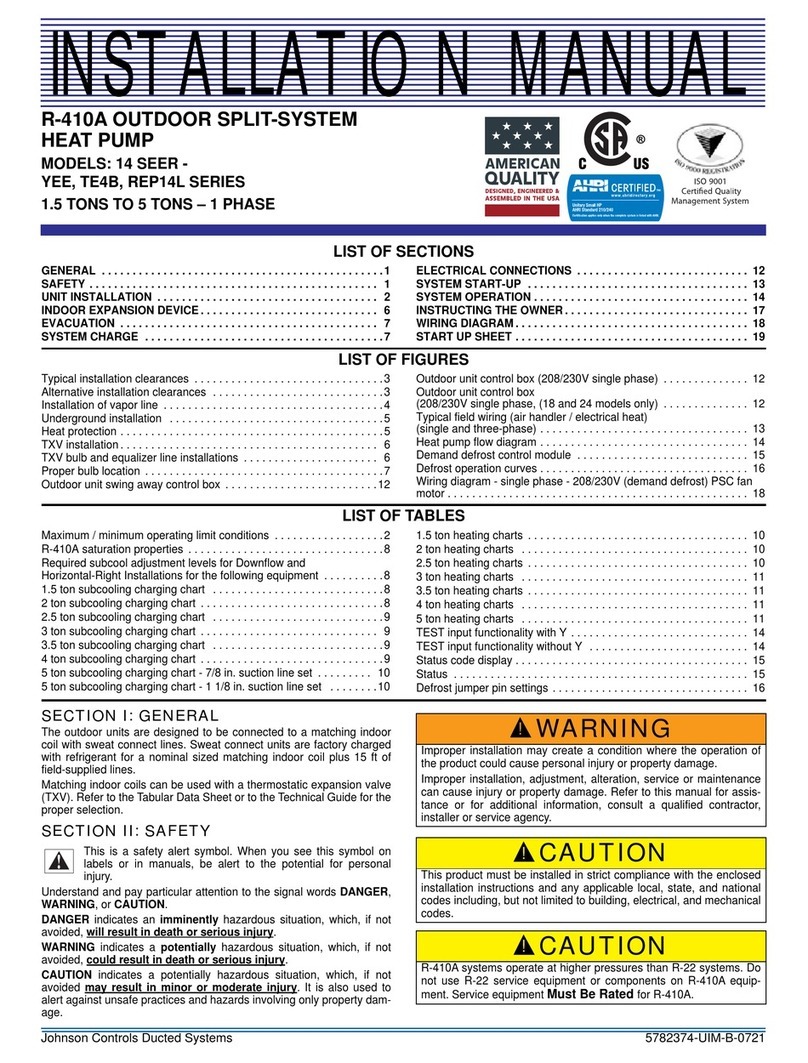
Johnson Controls
Johnson Controls Duct R-410A installation manual

CTC Union
CTC Union EcoHeat 5 Installation and Maintenance

Daikin
Daikin RKS20LVMA Service Manual Removal Procedure

Nibe
Nibe Compact Sol 300 Installation and maintenance instructions

Klimaire
Klimaire KCHD Series engineering data

Daikin
Daikin ComfortNet DX18TC Series Service instructions
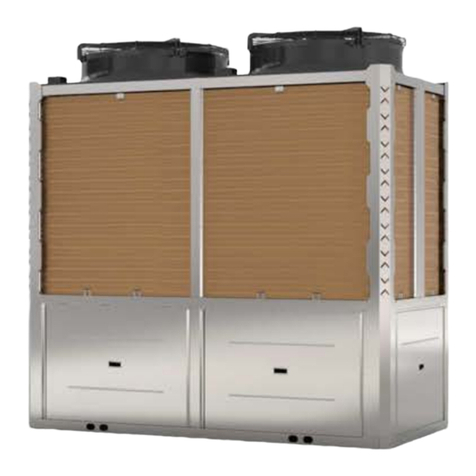
evoheat
evoheat CS-i Series Installation & operation manual
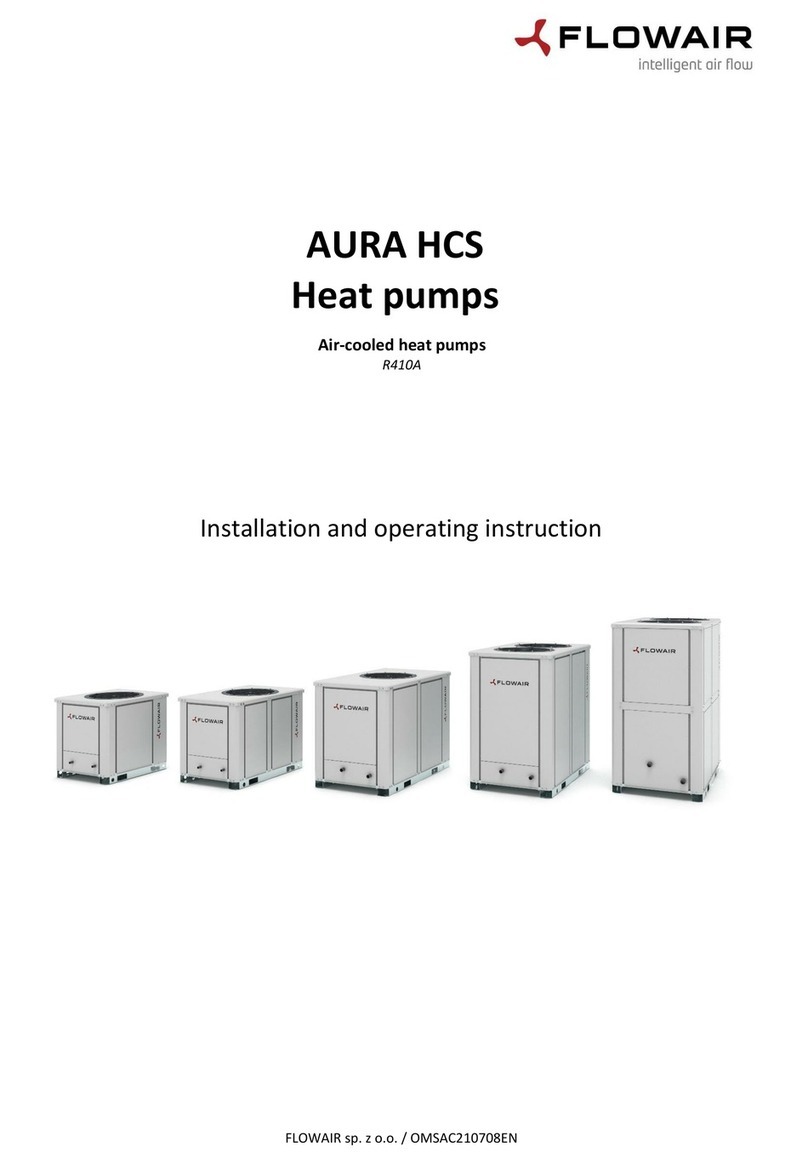
flowair
flowair AURA HCS Series Installation and operating instruction
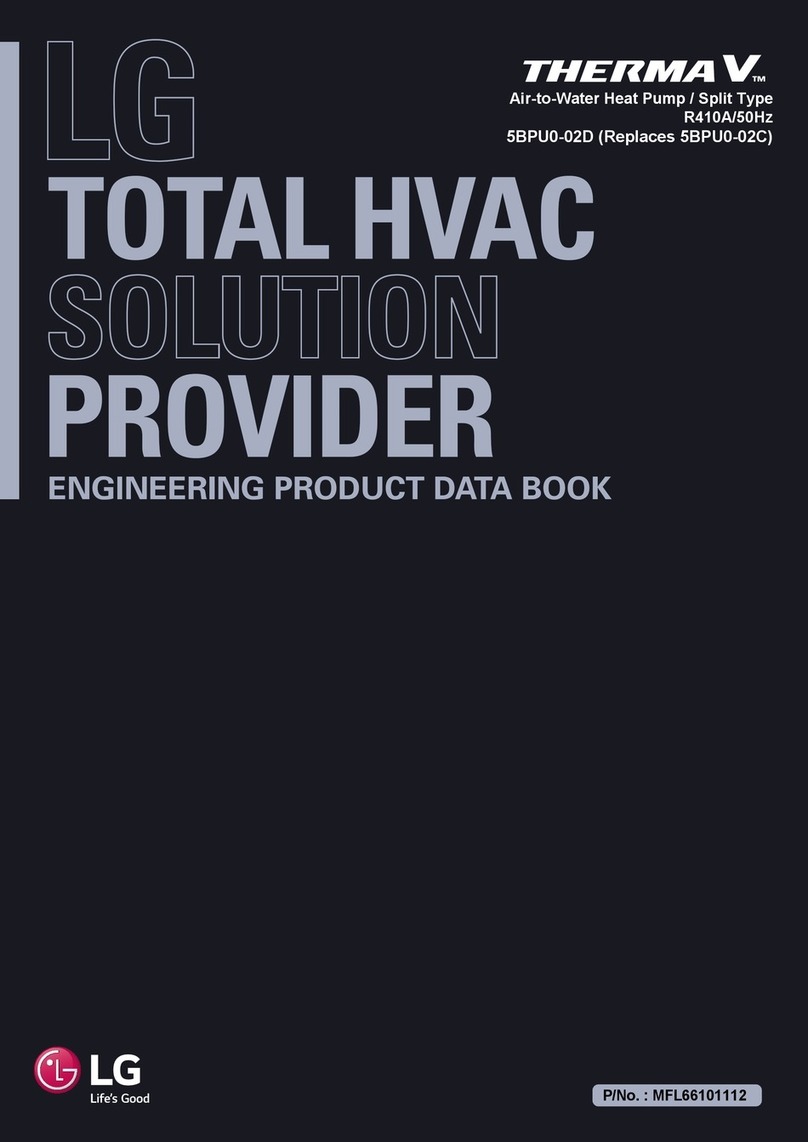
LG
LG 5BPU0-02D Engineering product data book

Energie
Energie AquaPura Split 300i Technical manual
